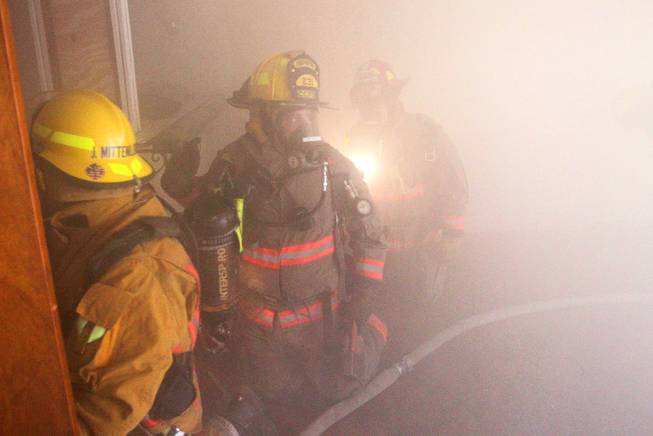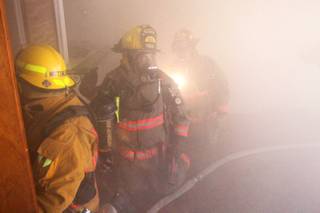
Members of Clark County Fire Department Truck 16 run a search-and-rescue drill inside a home filled with theatrical smoke near McCarran Airport on Monday, Dec. 17, 2012.
Tuesday, Dec. 18, 2012 | 2 a.m.
As smoke poured out of a home Monday afternoon near McCarran International Airport, a team of Clark County firefighters rushed in, searching for a trapped comrade.
Battling low visibility, the team of four searched the interior of the one-story house on their hands and knees. The firefighters worked their way around the perimeter, then went room to room. After a few minutes, the team emerged, dragging a human-sized dummy dressed in a firefighter’s uniform — the trapped colleague the crew had been searching for as part of a training exercise.
Throughout the next month, teams of Clark County firefighters will repeat this exercise as part of practice in rapid intervention, a technique required when a firefighter becomes trapped in a burning building.
“If there’s a collapse or a flashover, if there’s something that overtakes the crews that are inside, the (rapid intervention team) is standing by to take care of that,” Fire Capt. John Steinbeck said.
A rapid intervention team is designated at every active interior fire the Clark County Fire Department responds to, Steinbeck said.
Firefighters rarely get trapped inside of burning buildings, but Steinbeck said when they do, it’s often a race against the clock to rescue them before their 30-minute oxygen supply runs out.
“We’re on 30-minute packs of air when we enter, and depending on how hard you’re working, it might not last that long anyway. Depending on when they got lost, that’s how long you have to get them out. That’s why it’s a rapid intervention team,” Steinbeck said.
When they’re not rescuing other firefighters, the rapid intervention team usually works the exterior of the building, opening doors and windows to provide more points of access for firefighters. The team also is responsible for monitoring which firefighters are in a building at a given time and making sure they all make it out, Steinbeck said.
“In our industry, it’s what we call a low-frequency, high-risk event. … We don’t have a lot of buildings collapse on us, but when they do, you have to be well trained on it because you’re not doing it every day,” he said.
The rapid intervention drill also gives firefighters a chance to practice skills they use every day, such as forcibly entering a building or searching for a trapped person in thick smoke, Steinbeck said.
In the front yard of the training home, which is owned by the Clark County Aviation Department, firefighters practiced knocking down a reinforced door and sawing through the hinges on a gate while others searched for the trapped dummy inside the house.
Steinbeck said the firefighters hadn't seen the interior layout of the home before the training drill and that each unit was timed as they made their search.
Any lessons learned from the drill, whether it involves improving communication or refining search techniques, will be reviewed by department leaders and incorporated into future training, he said.


Join the Discussion:
Check this out for a full explanation of our conversion to the LiveFyre commenting system and instructions on how to sign up for an account.
Full comments policy